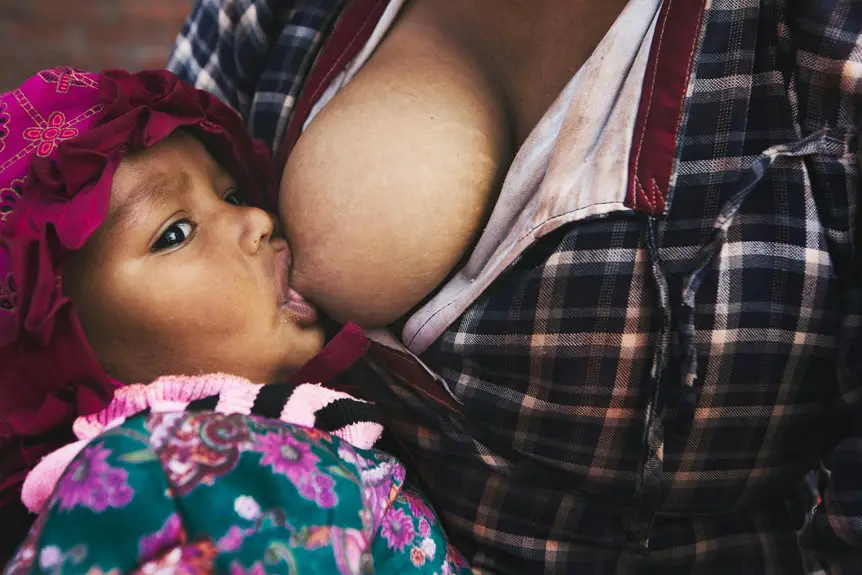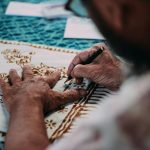You care for batik fabric by washing it gently in cold or lukewarm water using mild, pH-neutral detergent to protect the intricate designs. Turn it inside out to avoid damage, and never wring or scrub the fabric. Air dry it in the shade to prevent fading, and iron on low heat with a cloth barrier. Storing it away from sunlight and moisture keeps it vibrant longer. Keep these basics in mind, and you’ll discover even more ways to maintain its beauty.
Table of Contents
Key Takeaways
- Hand wash batik fabric gently in cold or lukewarm water using mild, pH-neutral detergent to preserve colors and patterns.
- Turn batik inside out before washing and ironing to protect intricate designs from damage.
- Air dry batik fabric in shaded, well-ventilated areas away from direct sunlight to prevent fading.
- Iron batik on low to medium heat while slightly damp or with a pressing cloth to avoid scorching.
- Store batik in a cool, dark place folded with acid-free tissue paper, away from moisture, pests, and sharp objects.
Understanding Batik Fabric Composition
Batik fabric combines artistry and craftsmanship through a unique wax-resist dyeing technique. When you look at batik, you’re seeing more than just patterns; you’re witnessing a process that involves applying wax to fabric before dyeing it. This method creates intricate designs by preventing dye from penetrating the areas covered in wax.
Most batik fabrics are made from natural fibers like cotton or silk, which absorb dyes well and feel comfortable on your skin. Understanding these fibers helps you appreciate why batik needs special care. Synthetic materials rarely undergo traditional batik processes, so recognizing the fabric’s composition guarantees you treat it correctly.
Knowing these basics sets the foundation for preserving the beauty and longevity of your batik pieces.
Gentle Washing Techniques for Batik
Since delicate fibers and wax-resist patterns require extra care, you should always wash batik fabrics gently to preserve their colors and texture.
Start by turning your batik inside out to protect the design. Use cold or lukewarm water to avoid shrinking or fading.
Gently hand wash your batik by swirling it softly in water; avoid scrubbing or wringing. If you must use a washing machine, place the fabric in a mesh bag and select a delicate cycle with a slow spin.
Rinse thoroughly but gently to remove soap without damaging the fabric. After washing, press out water by pressing the fabric between towels instead of twisting it.
Finally, air dry your batik flat or hang it away from direct sunlight to maintain its vibrant appearance.
Choosing the Right Detergents
You’ll want to pick mild detergents when washing your batik fabric to keep its colors vibrant and patterns intact.
Harsh chemicals, especially bleach products, can damage the delicate dyes and weaken the fabric.
Stick to gentle options to protect your batik and extend its life.
Mild Detergents Only
Although it might be tempting to use strong detergents for quick cleaning, choosing mild detergents is essential to preserve the colors and texture of your batik fabric. Harsh chemicals can strip the vibrant dyes and weaken the delicate fibers, causing your batik to fade or become rough.
Instead, opt for gentle, pH-neutral detergents designed for delicate fabrics. These cleaners effectively remove dirt without compromising your fabric’s integrity. When washing, use cool or lukewarm water to prevent damage and always test the detergent on a small, hidden area first.
Avoid Bleach Products
Choosing mild detergents helps protect your batik fabric, but you should also steer clear of bleach products. Bleach can strip colors and damage delicate wax patterns. Even oxygen-based bleaches might fade your fabric’s vibrant designs. Instead, opt for gentle, color-safe detergents that preserve the fabric’s integrity.
Here’s a quick guide to detergent choices for your batik:
| Detergent Type | Safe for Batik? | Notes |
|---|---|---|
| Mild liquid detergent | Yes | Best for hand washing |
| Color-safe detergent | Yes | Protects colors |
| Oxygen bleach | No | May cause fading |
| Chlorine bleach | No | Harsh, damages fibers |
| Fabric softeners | Use sparingly | Can affect wax finish |
Avoid bleach to keep your batik vibrant and long-lasting.
Proper Drying Methods to Avoid Damage
After washing your batik fabric, you’ll want to air dry it properly to keep the colors vibrant and the material intact.
Always avoid direct sunlight, which can fade the delicate patterns over time. Instead, hang your fabric in a shaded, well-ventilated area for the best results.
Air Drying Techniques
Proper air drying is essential to preserving the vibrant colors and delicate patterns of your batik fabric. After washing, gently squeeze out excess water without wringing, which can distort the fabric.
Lay your batik flat on a clean, dry towel to absorb moisture, then transfer it to a drying rack or hang it using padded hangers to maintain shape. Make certain air circulates freely around the fabric to speed drying and prevent mildew.
Avoid using clothespins that might leave marks or creases. Position your fabric indoors or in a shaded, well-ventilated area to keep the fibers intact.
Avoiding Direct Sunlight
While drying your batik fabric, you’ll want to steer clear of direct sunlight to prevent fading and fiber damage. Instead, hang your fabric in a shaded, well-ventilated area where air can circulate freely.
Direct sun can break down the dyes and weaken the fibers, causing your batik to lose its vibrant colors and durability over time. If you dry indoors, place the fabric near an open window or use a fan to speed drying without exposing it to harsh light.
Avoid using a dryer, as heat can also harm the delicate wax-resist patterns. Taking these precautions helps maintain your batik’s beauty and longevity, ensuring it stays vibrant and strong through many wears and washes.
Ironing Tips for Batik Textiles
Because batik fabric often has delicate dyes and intricate patterns, you’ll want to iron it carefully to avoid damage.
Always turn the fabric inside out before ironing to protect the design. Use a low to medium heat setting—too much heat can fade colors or scorch the fabric.
Iron while the fabric is slightly damp for best results or use a pressing cloth to create a barrier between the iron and the batik. Avoid using steam directly on the fabric, as excessive moisture can affect the dye.
Move the iron gently and avoid pressing too hard to maintain the fabric’s texture. By following these steps, you’ll keep your batik textiles looking vibrant and well-maintained for years to come.
Storing Batik to Prevent Fading and Wrinkles
To keep your batik fabric looking fresh, follow three key steps when storing it to prevent fading and wrinkles.
First, always store your batik away from direct sunlight. Sunlight causes colors to fade quickly, so choose a dark, cool closet or drawer.
Store batik in a dark, cool place to prevent fading from sunlight exposure.
Second, fold the fabric carefully along natural creases rather than cramming it into tight spaces. This reduces the chance of deep wrinkles forming.
Third, avoid hanging batik for long periods, as this can stretch the fabric and distort the patterns. Instead, place acid-free tissue paper between folds to cushion delicate areas and keep the fabric breathable.
Handling Stains on Batik Fabric
If you notice a stain on your batik fabric, acting quickly can make all the difference in preserving its vibrant patterns.
First, gently blot the stain with a clean, white cloth to absorb excess liquid—avoid rubbing, which can spread the stain or damage the fabric.
Next, rinse the stained area with cold water to loosen the stain particles. For tougher stains, use a mild detergent diluted in water and apply it carefully with your fingers or a soft cloth.
Always test any cleaning solution on a small, hidden area first to verify it doesn’t affect the colors.
After treating the stain, rinse thoroughly with cold water and air dry away from direct sunlight.
Avoid harsh chemicals and bleach, as they can harm the delicate batik dyes.
Preserving Vibrancy Through Regular Care
While batik fabric naturally boasts rich colors and intricate patterns, you can keep its vibrancy alive by adopting a consistent care routine. Always wash batik in cold water with mild detergent, avoid direct sunlight when drying, and store it away from harsh light to prevent fading. Gentle handling during cleaning preserves the wax-resist designs.
| Care Step | Why It Matters | Tip |
|---|---|---|
| Cold Water Wash | Prevents color bleeding | Use mild detergent |
| Shade Drying | Avoids sun damage | Hang in a well-ventilated area |
| Proper Storage | Reduces fabric degradation | Store in breathable bags |
Frequently Asked Questions
Can Batik Fabric Be Used for Upholstery or Heavy-Duty Items?
Think of batik fabric like a delicate butterfly—it’s beautiful but not built for heavy-duty use. You shouldn’t use it for upholstery since it can wear quickly; it’s best suited for lighter, decorative purposes instead.
Is Batik Fabric Suitable for Outdoor Use or Exposure to Sunlight?
Batik fabric isn’t ideal for outdoor use or prolonged sunlight exposure because its colors can fade and the fabric may weaken. You’ll want to keep it indoors or in shaded areas to preserve its beauty and durability.
How Long Does Batik Fabric Typically Last With Proper Care?
With proper care, your batik fabric can last for many years, often decades. You’ll want to avoid harsh washing and direct sunlight to keep colors vibrant and the fabric strong over time.
Are There Specific Cultural Etiquettes When Gifting Batik Fabric?
When gifting batik fabric, you should respect its cultural significance by presenting it with both hands and expressing appreciation for its artistry. Avoid giving dark or somber colors for joyous occasions, and consider the recipient’s cultural background.
Can Batik Fabric Be Machine Washed on a Delicate Cycle?
You can machine wash batik fabric on a delicate cycle, but you shouldn’t use hot water or harsh detergents. Always turn it inside out and wash with similar colors to keep the colors vibrant and prevent damage.
- Where to Buy Sherpa Suede Fabric - July 12, 2025
- How to Draw or Illustrate the Texture of Suede Fabric - July 12, 2025
- What Is Baseball Suede Leather Fabric? - July 12, 2025







